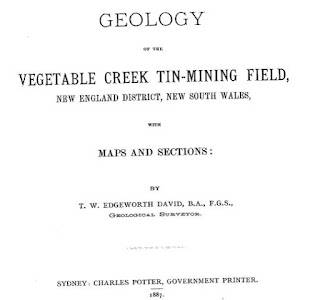| Photo by Wwoofa via the Australian Lapidary Forum |
This is a well-known mineral collecting locality in
northern NSW, on the western edge of what is commonly called the New England
region. Unfortunately it is a place I’ve never visited so I am depending on the
descriptions of others.
The Inverell Tourism website has this to say:
“Wallangra Fossicking Area. Wallangra located north of Inverell has an area near the hall where you can hunt for Black Tourmaline in Quartz, once again this is a dry fossicking area. Contact Details: Wallangra Hall, Wallangra (65km north of Inverell) Ph: (02) 6728 8161.”
You may not find that
particularly helpful. Knowing that the spot is near the Hall is good, but you
also need to know that this is on the left hand side of the Yetman road. I’m sure
you will find the place OK without ringing Wallangra.
The spot is open freely
to fossickers. Please do the right thing and leave your mechanical diggers at
home. As well as your specimens, take home all your rubbish and other people’s
as well if you come across any.
There is a stack of
information available on the Australian Lapidary Forum. I suggest you become a
forum member so you can access it. Here. You can then contribute to the Forum by telling members about your visit to Wallangra.
There are a number of
websites describing visits to Wallangra. “Frosty’s
Aussie Adventures” (here) should answer most of your questions.
Thank you Wayne for showing us what should be available from the Inverell
Tourism website.
I will point out at this
stage that Wallangra and Wallangarra are quite different places.
The latter is just across the NSW border into Queensland on the New England
Highway.
This is an extract from
the Inverell 1:250000 geological map. It shows that Wallangra is situated in an
area marked Pg (Permian Granite, actually part of the Bundarra Suite).
The Australian Stratigraphic Units Database
contains this definition of the “granites” of the Bundarra Suite:
“Coarse- to
very coarse-grained, porphyritic and equigranular
(biotite)-(muscovite)-(garnet)-(cordierite) granite and leucogranite;
K-feldspar megacrysts abundant in places.” This is the host rock in which the Wallangra tourmaline in
quartz bodies are found.
I have been
unable to find any account of the detailed geology of the occurrence.
Mindat (here), however, regards the site as
significant. Here is what a search on the location produces:
“Latitude
& Longitude (WGS84):
|
29° 13' 54'' South , 150° 53' 4'' East
|
Latitude
& Longitude (decimal):
|
Located south of Texas, Qld.
Wallangra (in Northern New South Wales) was the site of a quarry, the area is
now a designated Fossicking area. There is a quartz outcrop which contains
tourmaline.
You will notice that the
word ‘tourmaline’ is in quotes. This is because tourmaline is the name of a
mineral family, rather than an individual mineral. In this case, the mineral is
schorl – commonly called black tourmaline. If you want to read more about the
tourmaline group, check this Mindat reference here.
 |
| Photo by Wwoofa via the Australian Lapidary Forum |
 |
| Photo by earthound via the Australian Lapidary Forum |
https://johnsbluemountainsblog.blogspot.com/2013/12/links-to-all-blog-entries-and-relevant.html
All Blue Mountains blogs and videos
All New England and other Geology blogs and videos













